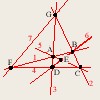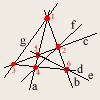

"For every configuration
of Points and Lines,
there is an exactly identical configuration
of Lines and Points."
In other words,
the rôles of Point and Line may be exchanged.
(Aha! In fact, it is the rôles of interpunctual and interlinear intervals that may be exchanged! Intervals define ‘configuration’.)
Any given point (such as black A, on the right) may be made the dual of any given line, (such as dashed black line a, on the right), by drawing two more lines, (such as the feint blue lines, b and c, on right), in the given point to cut the given line in two more points (blue points B and C).
These extra lines must obviously be in the plane common to the given line and the given point. Then the given point is defined by the two new lines, while, dually, the given line is defined by the two new points corresponding to those two new lines.
There need be no other manner of association between such lines and points, so they are generally pairable, but not uniquely paired.
Polarity
The interactive animation below shows
- a point (D, the Pole) interacting with a conic to produce the polar line (d, the Polar)
- a line (f, the Polar) interacting with a conic to produce the polar point (F, the Pole)
Drag point D, or drag line f (by dragging E, or f round E).
Note especially thatwhen a Pole lies in the conic,
so does its Polar.
This illustrates that if a line is to lie in a curve at a point, it does so by taking up the direction of the curve at that point.
That is, the line (the Polar) is tangent to the curve at the Pole.
But there is no provision for Curvature in the axioms of Projective Geometry.
The consequences of this are worked through in detail here, where it is shown that the special curve we need is a plane cut of a cone—which is a conic section, or conic, for short.
The key here is that
a conic is cut by a straight line in exactly two points.
When that line is tangent to the conic, those two points have degenerated into one (double) point—and then
just that tangent is uniquely associated
with just that one double-point,
and so point and tangent meet the requirements for
a pole-and-polar pair.
We see that point D is defined by two tangents at two points on the conic, and that line d joining those points is a chord of the conic . It follows that
point D and line d are uniquely associated,
and so are also
a pole-and-polar pair.
Polarity propagates from its parent conic!
Development
Let points A and B, respectively, be defined (in the way indicated above right) as the poles of chords a and b, respectively, of a conic. Let
- line m be the join of points A and B
- point M be the point common to the chords.
Then, because they are uniquely associated—
- line m the polar of the point M
- point M is the pole of line m.
And because M and m are thus shown, indirectly, to be Pole and Polar, we know that the two tangents to the conic through point M touch the conic at the two points, K and L, of intersection of line m with the conic. This is the direct expression of the polarity of M and m.
Then—
- Any line in point M must have its pole in line m.
- Any point in line m must have its polar in point M
Thus—
- a line (g, say) from M through A has its pole G both in line m, and chord a.
- a line (h, say) from M through B has its pole H both in line m, and chord b.
Also—
- The interval on m between A and G, the intersection of a with m, is also the interval between G and A, the intersection of g with m.
- The interval on m between B and H, the intersection of b with m, is also the interval between H and B, the intersection of h with m.
Site Map
Cones
Conics